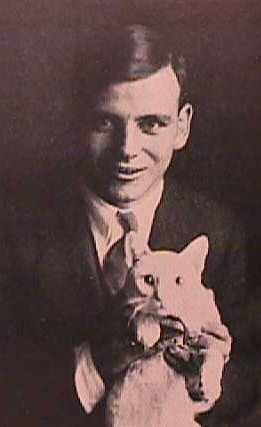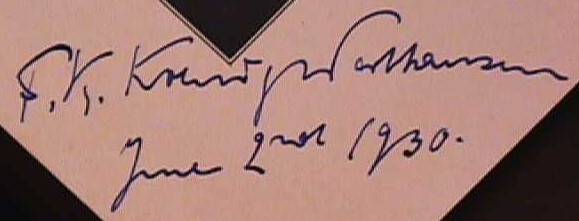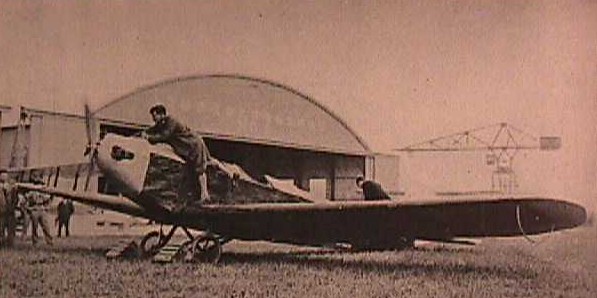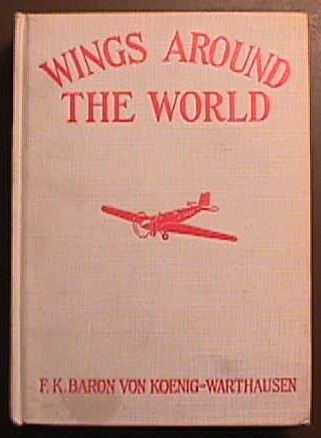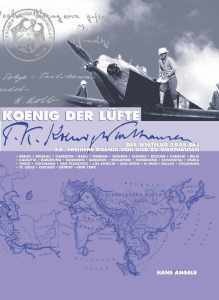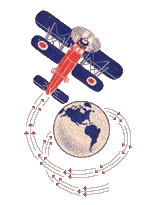Friedrick Karl Baron von Koenig-Warthausen was born in Germany and was educated in England
where he had an early passion for aviation. In May 1929, when he was 22 years old with the
assistance of his parents, he purchased a Klemm aeroplane (type L-20B1 #D-1433) with a Daimler
20 HP motorcycle engine. He used his new plane to obtain his pilot's license. His plane
became his comrade and was thus named "Kamerad."
President von Hindenburg created the "Hindenburg Cup" to be awarded to the amateur pilot
completing the best sporting flight of the year. Koenig-Warthausen decided to compete for
this honor by flying from Berlin to Moscow. He outfitted his Klemm with a minimum of
equipment including an emergency flare-gun, a portable compass, some tools and a few charts.
This equipment complemented the basic plane instruments which included an altimeter, fuel
gauge, oil pressure gauge and a thermometer to measure outside air temperature.
He took off from Tempelhof Airport in Berlin on August 9, 1929 with 50 gallons of gas. He
flew over Danzig and crossed Beresina River and after 14 hours landed in a small village about
ten miles outside of Moscow. The next day he continued his flight landing at Chodinka, the
aerodrome of Moscow. He was pleased with his success and decided to continue flying east. He
wired his parents announcing his intentions and on August 15th he departed Moscow, crossed the
Caucasus Mountains and landed in Baku on the Caspian Sea. He stayed in Baku for five days.
He flew south along the western coast of the Caspian Sea and landed in Pachlevi, Iran on his
way to Teheran.
On September 23rd, he set out again, making a forced landing at Isfahan, Iran where he
replaced a fuel transfer valve. Three days later he took off for Shiraz, Iran where he again
had to make a forced landing. In order to take off, he and some local help built a runway
which took four days to complete. Again in the air, he set out for Bushire, Iran.
Unfortunately, he ran out of gas and made another forced landing. Two more days and he was
again in the air headed for Bushire. On his arrival there, he found out that he won the
"Hinderburg Cup." By coincidence while in Bushire, he met Baron von Huenefeld who was on his
way with K.G. Lindner making his way to Tokyo on their round-the-world flight attempt. The two
German pilots had much in common and this chance meeting influenced Koenig-Warthausen to
continue flying east to Karachi. On the way, he landed at Bandar Abbas, Iran remaining there
for two days. He departed Bandar Abbas but shortly made another forced landing. His Daimler
engine was making an unfamiliar noise. He returned to Bandar Abbas to make the required
repairs. He flew along the coast of the Persian Gulf to Cape Jask. He crossed the border to
Baluchistan (Pakistan) and stayed overnight in Pasni, Pakistan.
The next day he made it to Karachi, Pakistan and stayed there for five weeks. Again he
pondered the decision whether to return to Germany or forge on flying east to Calcutta, India.
His decision was to continue flying east. He took off from Karachi on December 17th flying
the Indian route Uterlai, Jodhpur, Nasirabad and Agra. In Agra he spent two days visiting the
Taj Mahal and then continued flying east to Allahabad and Gaya. He departed Gaya on December
23rd and spent Christmas in Calcutta, India.
He was received there by the German consul who organized a side visit to Tibet and on his
return to Calcutta, met Ghandi. After spending two months in Calcutta and again canceling
his reservations to return to Europe by steamer, on February 5, 1930, he departed Calcutta
continued flying southeast toward Singapore. He landed at Akyab, Burma and then spent five
days in Rangoon. After spending five weeks in Bangkok, Thailand on March 25th, he continued
his flight toward Singapore. He was no longer flying solo as he had accepted a rare Siamese
cat as a gift from the wife of the Crown prince. Tanim accompanied him for the remainder of
his journey.
He made landings at Prachuap Khiri Khan and Songkhla on the Malay Peninsula and while
flying over Penang, encountered another tropical storm forcing him to land there. He remained
in Singapore for three weeks making a short flight south to "cross the equator." Finally, he
committed himself to continue east flying round-the-world rather than take a steamer to return
to Europe and his home in Berlin.
From Singapore he boarded a steamer for Hong Kong and Shanghai, China where he off-loaded
his Klemm. From there he took a short flight to Nanking where he visited with General Chang
Kai Check. Again, he boarded a steamer, this time for Kobe, Japan. He waited in Kobe for ten
days for clear weather and after his arrival in Tokyo spent three weeks there before embarking
from Yokohama on May 25th aboard the "Siberia Maru" steamer bound for the United States. The
steamer stopped in Honolulu, HI and arrived in San Francisco on June 8, 1930. His "Kamerad"
was transported to Alameda, CA and it was there that Koenig-Warthausen learned of the death of
his pilot friend, Baron von Huenefeld. To honor his comrade, he changed the name of his Klemm
plane to "Huenefeld."
He was pleasantly surprised by the hospitality extended to him and considered America to
be a paradise for aviators. He made several local flights including one above the Golden Gate
Park. After ten days in San Francisco, he set out on June 19th for Los Angeles and San
Diego. From San Diego, he made two side flights into Mexico before heading for El Centro, CA,
Tucson, AZ and El Paso, TX. His flying companion, cat began to be referred to as "Felix" by the
American press after the popular cartoon character, "Felix the Cat."
On July 12, 1930 when in El Paso, while in a taxi going to the airport, he was involved in
a serious traffic accident. His convalesce took two months. During his
convalescense on August 26th, the Graf Zeppelin departed Los Angeles, CA on its final leg of
its flight round-the-world. It followed a circuitous route via northern Mexico, through
southwestern US, then north to Chicago and Wisconsin and just into Canada, east to Detroit,
Cleveland and finally New York to its terminus at Lakehurst, NJ. As the Graf Zeppelin passed
over El Paso on August 27th, Koenig-Warthausen watched it from the ground and felt very proud
for his German countrymen. Hugo Eckener commented that the "Huenefeld" aeroplane was the
little brother of the Graf Zeppelin. On September 15th Koenig-Warthausen took off
heading east toward New York City. He landed at Big Spring, TX and the next day flew to
Sweetwater, TX. When taxiing over the muddy airfield, his Klemm sunk in the mud damaging his
left wing. The plane was transported over the road to Dallas where it was repaired.
He then flew to Oklahoma City, OK; Saint Louis, MO and Chicago, IL without incident.
On October 17th he left Chicago for Detroit, MI. On landing, he found that his Daimler engine
had a broken valve. After the engine repair, his departure was delayed four days. To shorten
his flight path to NY, he choose to fly over Canada. He had a forced landing in London,
Ontario because of water in his gas. Again bad weather caused him a two day delay before he
was in the air again. But bad weather (snow) made him land in Hamilton, Ontario. He left the
next day for Buffalo, NY and proceeded to cross New York State with stops at Syracuse, Little
Falls and Albany. From Albany, he flew in bad weather following the Hudson River south. He
crossed over Westchester County, the Long Island Sound and landed at Roosevelt Field on Long
Island.
On November 15, 1930, he sailed from New York City with his "Huenefeld" lashed on the deck
of the "Bremen" steamer. He arrived back in Germany at Bremerhaven on November 22nd to be
welcomed by a special delegation of German pilots. His plane was readied for the flight to
Berlin and the next day he was again in the air. Bad weather (fog) forced him to land in
Hanover, Germany. He left his plane there and traveled to Berlin by train and car arriving
there on November 23, 1930. He received the "Hindenburg Cup" he had won the year before. He
had soloed round-the-world in his single-engine, open-cockpit, low-wing Klemm in 15 months
covering 20,000 miles in 450 flying hours using less than 1,000 gallons of gas.
Koenig-Warthausen sought no records but became the first person to pilot a plane solo
round-the-world. He was inexperienced but resourceful, he solved problems that would discourage
others, and he had a determination that will be respected by all, forever.
